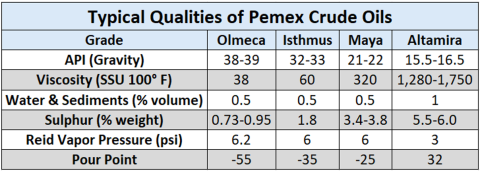Locator: 47116OIL.
This was posted years ago. At the time I knew less about crude oil so there may be errors, both content errors and typographical errors. I'm posting it again without changes, except for expanding on Mexico / Pemex.
******************************
Original Post With Pemex Update
FAQ #88 over at the "FAQs Page."
Disclaimer: some/much/all of this could be wrong. I've put this
together over the years, from different sources. Information is not
always confirmed and often not updated. It's for my own personal
interest to help me sort this out. This should not be used by folks who
are seriously invested in this issue.
April 18, 2019: Argus announces two new benchmarks: WTL (West Texas Light) and NSD (North Sea Dated).
- From the first link;
- WTI: Cushing
- WTI Permian: 40-44°API
- WTI Midland: Midland terminals (light oil, 44.1-49.9°API)
- WTL: Houston (light oil, 44.1-49.9°API)
February 18, 2019: see heavy oil, a primer, here.
NYMEX:
- light crude oil for domestic U.S. oil as having an API gravity between 37° API and 42° API
- light crude oil for non-U.S. oil as being between 32° API and 42° API
- light crude oil as having a density API gravity greater than 30.1°
- API gravity greater than 35° API
- light crude oil as being between 27° API and 38° API
This variation in definition occurred because countries such as Canada and Mexico tend to have heavier crude oils than are commonly found in the United States, whose large oil fields historically produced lighter oils than are found in many other countries.Loop Sour: see this post.
LOOP Sour comprises US Gulf of Mexico grades Mars and Poseidon and a crude blend called Segregation 17, named after a cavern into which the Middle Eastern grades Arab Medium, Basrah Light and Kuwait Export Crude can be delivered. The grade has been most similar to Mars in terms of API gravity over the past 12 months, averaging 0.33 degree off Mars’ typical 29.44; and from a sulfur standpoint, averaging 0.02 percentage point off Arab Medium’s typical 2.53%.
Much, but not all, information below comes from wiki.
WTI
- A wide variety of benchmark crude oils worldwide are considered to be light. The most prominent in North America is West Texas Intermediate (WTI):
- API gravity of 39.6° API; lighter than Brent, but not by much
- sulfur: 0.24% (sweet oil is defined as oil with sulfur content less than 0.5%)
- "basket" changed in early 2017 due to older fields depleting
- Platts will add Norway's Troll to the basket of four British and Norwegian crude grades which is already uses to assess dated Brent from January 1, 2018
- this will join Brent, Forties, Oseberg, Ekofisk, or BFOE as they are known
- Troll: a light, sweet crude; operated by Statoil (also contributes to the Oseberg, Statfjord, Gullfaks, Grane and Asgard streams)
- the most commonly referenced benchmark oil from Europe is Brent Crude, which is
- 38.06° API
- the third most commonly quoted benchmark is Dubai Crude, which is 31° API
- this is considered light by Arabian standards but would not be considered light if produced in the U.S.
Murban Crude:
- became a "thing" after sanctions on Russia cut Russia oil to the US
- light sour; very similar to Bakken (light) but much more sulfur content
- see blog entry here;
Saudia Arabia's Ghawar field:
- the largest oil field in the world, Saudi Arabia's Ghawar field
- light crude oils ranging from 33° API to 40° API (see above; most would consider Saudi oil to be medium/heavy; and sour
- 31.4°
- sulfur: 0.96%
36 to 44 degrees API. The quality of this oil is excellent, almost identical to WTI. The benchmark crude oil is West Texas Intermediate, which is 40 degrees API sweet crude. It is the benchmark because it requires the least amount of processing in a modern refinery to make the most valuable products, unleaded gasoline and diesel fuel.North Dakota Spearfish: 36°
- presentation, Corinthian, undated, perhaps early 2014
- sulfur content: 0.8% to 1%
Mexico: generally heavy to medium-light; sulfur content (chart added May 1, 2024 -- link:
- Isthmus: 21.8°.3.3% sulfur
- Maya: 33.4°; 1.35% sulfur
- Olmeca: 37.3°; 0.84% sulfur
Crude oil found in Iraq varies significantly in quality, with API gravities generally ranging from 22° (heavy) to 35° (medium - light).
Over 70% of national oil reserves are below 28° API and the International Energy Agency (IEA) predicted in its 2012 report on Iraq that future production is likely to include a larger share of heavier crudes. However some of the crudes produced at the Taq Taq field in the norther semi-autonomous Kurdistan region are as light as 48° API, dubbed by Reuters as "champagne crude." See Taq Taq here.California: heavy oil; pdf here -- old data, from 2004, but type of oil probably has not changed
- Kern County: heavy oil with 1.2% sulfur; accounts for 75% of California's on-shore production
- Los Angeles Basin: heavy oil; sulfur content 1.7% to 2.0%
- Off-shore: intermediate for the most part, 18° (heavy) to 36° (medium-light)
Seeks low-sulphur, light oil, September 1, 2015:Venezuela: heavy oil, similar to Canadian oil sands.
Net crude exporter Petroecuador issued a tender to import 30 million barrels of light sweet crude over the course of a year in an attempt to maximize diesel and gasoline production when its Esmeraldas refinery comes back online in the fourth quarter, market sources said Tuesday.
Petroecuador is seeking 30 million barrels of low sulfur crude oil with an API gravity of 28 degrees to be delivered in a one-year period, according to a tender issued late Monday.
The state-owned oil company is seeking the barrels "in order to optimize the Esmeraldas refinery operations, once the revamping has been complete," the tender said.

No comments:
Post a Comment
Note: Only a member of this blog may post a comment.